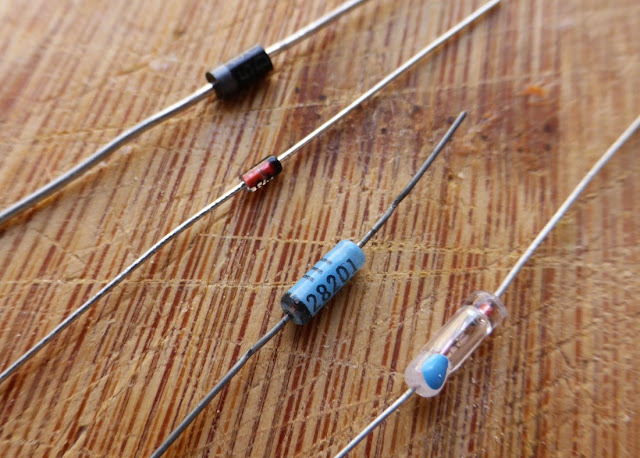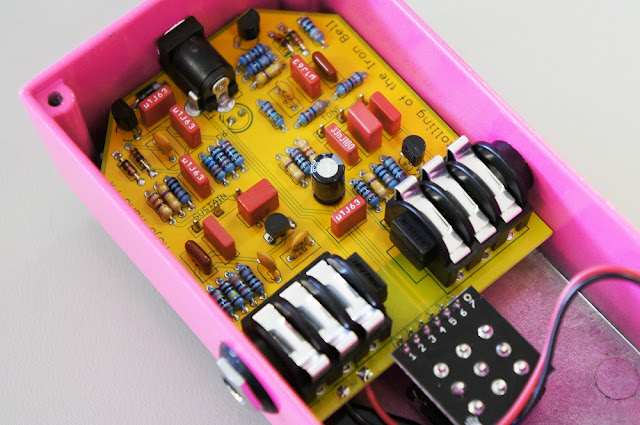I like to say that electronics are like Legos.
If you step on it, it hurts! Just kidding, it seriously works like Legos as well! 😃
You have to choose different bricks (the electronic components: resistors, capacitors, diodes, IC...) and to assemble all of them following a schematic.
The only problem is: like there are different colors for the lego bricks,
electronic components are declined in various versions, with the same value.
For instance, many many different capacitors can be found with the same capacitance value: Panasonic SMF, Wima MKP2, FKP2, MKT standard... What a mess! Lets try to make order in all of this, and to see which capacitors are best suited for our use (guitar pedals).
The 6 elements of capacitors
There are globally 6 main types of capacitors: electrolytic, ceramic, film, tantalum, polystyrene and silver-mica capacitors.
The type of the capacitor is simply a description of what it is made of.
You should also look up for the capacitor working voltage (more on that in a bit). The tolerance of a capacitor is the maximum difference between a capacitor theoritical value and its real value. You should always look for that too; some capacitors can have tolerance values as huge as 40%!
The smaller the tolerance, the better. 😊
Here are a few examples of through-hole capacitors. From left to right: 150pF ceramic capacitor, 1uF tantalum capacitor, 10nF Panasonic SMF film capacitor, 10uF Panasonic FC electrolytic capacitor and a 0.33uF Wima MKP2 film capacitor.
Lets start:
- Electrolytic capacitors: they are cylindric. They usually have high capacitance value, so I would advise to use this kind of capacitors for any value above 1uF.
They also are polarised most of the time, so beware with the orientation. A good model which I use a lot is the Panasonic FC serie: top quality and a nice black and gold look!
- Ceramic capacitors: they are used for small capacitance value, around 10-500pF. They are not very appreciated by audiophiles, because they do not let pass some bass frequencies: they work as a high pass filter at 100Hz.
If you make your guitar signal goes through this kind of capacitor without any alternate solution (another capacitor in parallel for instance), you will loose bass. However, when placed at strategic points of the circuit, they are very practical to choose how many trebles you want to go through. Usually, they have a high tolerance, so I recommand to look after models with a low tolerance.
- Film-mica capacitors: they are used for low values like pF like ceramics. They are better than the ceramics, however, they are much bigger and more expensive. I would advise you to stay with the ceramics and save money!
- Tantalum capacitors: drop-shaped capacitors, used for values around uF. They are not very good for audio, and quite expensive. The only advantage compared to other capacitors of the same values (electrolytics, film caps) is the space saving. Sometimes, their defects in audio can be useful to create a harsh sound good for some kind of dirty fuzz like big muff (for instance, the black arts toneworks pharaoh fuzz uses tantalum capacitors)
My 2 cents about tantalum capacitors:
Tantalum capacitors are great because they are so small, so they are use in many electronics devices like your phone or computer. However, they are many ethical problems with coltan (the mineral used to make tantalum) mining, with human rights violations. More infos
here. I try not to use tantalum caps because of that.
- Film capacitors: our favorites! Their value is in a large range from nF to 1 uF. You will use this kind of capacitors a lot! Moreover, most of them are really good for audio applications: MKP2 from Wima are a reference in the audio world. Panasonic SMF ECQ are also great, and have an easier-to-work-with shape with long lugs. Finallys, MKT standards are also quite good, and cheaper.
Here is a table to know which capacitor to use:
| Value |
Capacitor type |
Examples |
| 10-1000pF |
Ceramic, Silver-Mica |
Vishay ceramic caps, military grade ones are nice too |
| 1nF-1uF |
Film |
Wima MKP2, MKS2, Panasonic SMF |
| 1uF and more |
Electrolytic |
Panasonic FC |
Except when indicated of course.
What about the working voltage?
The working voltage is the maximum voltage a capacitor can accept.
If you go above this voltage, your capacitor can be damaged! It is thus very important to use a tolerance which fits our usage.
In guitar pedal, we rarely use a voltage above 18V. So
any capacitor with a tolerance above 18V is good.
Generally speaking, the bigger the tolerance value, the better.
Beware! With bigger working voltage also comes a bigger capacitor size. Electrolytic capacitors in particular can be HUGE! So always check the capacitor size as well.
Examples of capacitors in commercial pedals
Lets review a few pedals that some of you migh already have on your pedalboard!
I will show you the guts of a few commercial pedals, and you will see what kind of capacitors they use.
Mojo Hand Iron Bell (Big Muff inspired fuzz):
Here, we can find ceramic capacitors (small yellowish ones) and Wima capacitors that are film capacitors as well (red squares). There are also Panasonic SMF (dark red capacitors). Very good capacitors overall! No surprises from this very good brand.
Fulltone OCD (overdrive / distortion)
Here, we can see lots of ceramic capacitors (blue "drops" everywhere on the circuit, and brownish round caps), and 2 electrolytic capacitors (black cylinders on the top of the circuit).
Bearfoot Pale Green compressor
Finally, in this Bearfoot pedal, we can see one tantalum capacitor (orange drop on the left of the circuit), MKT capacitors, probably Epcos brand (blue boxes), electrolytic capacitors of different sizes (small and big black and white cylinders). Good stuff here too!
Any questions? Suggestions? Post a comment!
To go further










